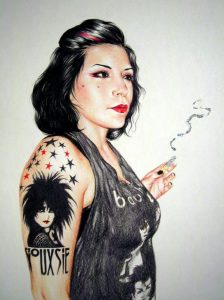
Art of Noise: Feminist Art and Popular Music Since 1977
Art of Noise: Feminist Art and Popular Music in Since 1977 is the first history of women artists who emerged from the hybrid art/music practices of the late 1970s, and their ongoing relevance to emerging feminist artists today.
Scholar Bernard Gendron has compellingly argued that rock music took over the avant-garde in the 1970s, holding “onto its ‘pop’ moorings while becoming ‘art.’’” Visual artists like Laurie Anderson and Linder Sterling started writing, performing, and recording music, and musical groups like Talking Heads and DISBAND treated their bands as performance art, blurring the lines between popular music and visual art in ways that have profoundly affected contemporary art ever since. This seemingly effortless crossing of the era’s art/music and high/low divides, as Gendron documents, was in reality born of “aggressive struggles on the part of popular culture for cultural empowerment.”
To Gendron’s history of this moment, in Art of Noise I additionally assert that these struggles often sprang from the era’s civil rights, feminist, and queer movements, which in the ‘70s sought new ways to reach broader audiences and to critique the myopia or elitism of these movements’ earlier iterations. Art of Noise tracks the history of such art/music hybrids from 1977—the oft-cited year in which both punk and hip-hop broke into the popular consciousness—through to the present, with a focus on artists in whose practices feminist politics were integral.
Art of Noise begins with women artists who emerged from the U.K. art-school system—such as Sterling, Caroline Coon, and Viv Albertine—and creative autodidacts from the D.I.Y. scene, like X-Ray Spex’s Poly Styrene, to combine visual art, music, and design in their varied careers at the start of the punk era. The focus then moves to their contemporaries in the New York “Downtown Scene” in which punk, No Wave, and electronic music similarly mixed with visual art and feminist politics in the work of artists like Anderson, Nan Goldin and Ann Magnuson. All these artists took inspiration from as well as critiqued the activist movements that preceded them, which Art of Noise follows on to the art cultures around hip-hop, hardcore, and Riot Grrrl in the ‘80s and ’90s and their ongoing inspiration to emerging artists today: artists such as Xaviera Simmons, who engages funk and DJ culture as a form of Black feminist community-building; genderqueer performers like Peaches, Mykki Blanco, and the LTTR collective, who use dance music and fashion as springboards for critique; Chicanx artists from pioneering L.A. punk Alice Bag to third-wave feminist painter Shizu Saldamando, who explore the political dimensions of punk’s Latinx narratives; and others who use music as a seductive, artistic form of protest that LTTR cofounder Emily Roysdon has called “ecstatic resistance.”
[“FIVE QUESTIONS” ABOUT THIS PROJECT IN CU CONNECTIONS]
[READ AN INTERVIEW WITH THE AUTHOR IN WESTWORD]
This project has also spun off into several exhibitions:
- Inner Ear Vision: Sound as Medium (curated with Raven Chacon and Robert Aiki Aubrey Lowe), Bemis Center for Contemporary Arts (2019)
-[Read the Bemis Center’s accompanying “gallery guide” for Inner Ear Vision]
–[Read Flash Art International review of the exhibition Inner Ear Vision: Sound as Medium]
- Danger Came Smiling: Feminist Artists and Popular Music, Franklin Street Works (2016)
–[Read the exhibition catalogue for Danger Came Smiling]
–[Read the Art in America review of Danger Came Smiling]